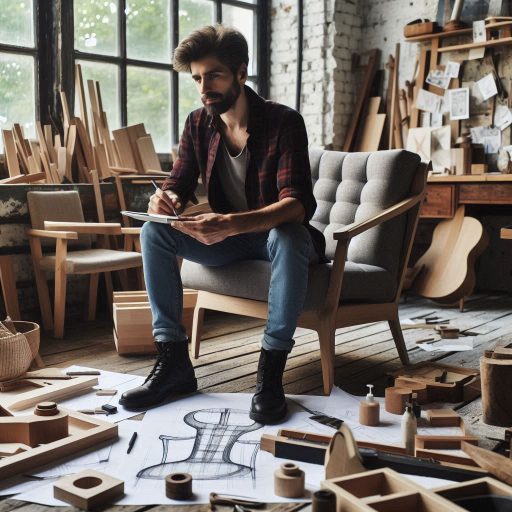Introduction
The role of a creative director is pivotal in any organization.
They shape the vision and direction of creative projects.
A creative director leads a team of designers, writers, and other creatives.
They ensure that every element aligns with the brand‘s identity and goals.
Creativity and innovation drive the success of any brand.
In today‘s fast-paced world, standing out requires fresh ideas.
Creative directors must foster a culture of innovation within their teams.
They encourage collaboration and brainstorming to generate unique concepts.
Without creativity, brands risk losing their relevance in a competitive market.
A typical day for a creative director is dynamic and multifaceted.
They start by reviewing ongoing projects and team updates.
Morning meetings often set the tone for the day.
In these meetings, they discuss goals and objectives with their team.
They may also review design drafts and provide feedback.
After meetings, creative directors dive into brainstorming sessions.
They often sketch ideas or create mood boards to visualize concepts.
Collaboration fuels creativity, and diverse perspectives enhance the process.
They encourage team members to share their thoughts and ideas freely.
Creative directors spend a significant amount of time communicating.
They liaise with other departments, such as marketing and sales.
This collaboration ensures that creative outputs align with business goals.
Clear communication fosters a unified vision across the organization.
Morning Routine
Wake Up Early to Start the Day
A creative director’s day starts early.
Rising before dawn gives a sense of calm.
The quiet morning hours foster creativity and focus.
The first task often involves engaging in creative activities.
Sketching ideas or brainstorming concepts sparks inspiration for the day ahead.
These activities set a positive tone.
Engage in Creative Activities Like Sketching or Brainstorming
After a short creative session, the next step is reviewing emails.
Checking messages early helps stay organized and informed.
The creative director scans for important updates or urgent requests.
They prioritize messages that require immediate attention.
This approach ensures they address key issues promptly.
Review Emails and Plan Out the Day’s Schedule
Next, the creative director plans the day‘s schedule.
They outline meetings, deadlines, and creative sessions.
This structured planning creates a roadmap for productivity.
A well-thought-out schedule helps maximize the day‘s potential.
The director allocates specific time blocks for focused work.
During this planning phase, they also assess ongoing projects.
They check the progress of team members and provide feedback.
This proactive approach keeps the team aligned and motivated.
It also encourages open communication, which fosters a collaborative atmosphere.
After planning, the director often takes a moment for self-reflection.
They might jot down goals for the day.
Setting clear intentions helps maintain focus and energy.
This practice not only boosts productivity but also enhances creativity.
Next, they usually grab a healthy breakfast.
Nutrition fuels the body and mind for the creative challenges ahead.
A good meal provides the energy needed for brainstorming sessions.
It also sets a positive tone for the day.
The morning routine may also include a brief workout.
Physical activity energizes the mind and helps clear thoughts.
Whether it‘s yoga, jogging, or a short walk, movement stimulates creativity.
It prepares the director to face the day with vigor.
Once fully prepared, the creative director transitions into work mode.
They often start by reviewing design concepts or marketing strategies.
This early focus on creativity paves the way for innovative solutions.
By the time they arrive at the office, the director feels ready to inspire their team.
Their energized morning routine fuels their passion for creativity.
It sets the foundation for a productive and successful day ahead.
Each morning is an opportunity to unleash creativity and lead with vision.
Read: Character Design Trends: What‘s Hot in 2024?
Collaborating with the Team
A creative director’s day often starts with meetings.
I gather the creative team to discuss ongoing projects.
Each member shares their progress and challenges.
This open communication fosters collaboration and innovation.
I encourage everyone to speak up, ensuring all voices are heard.
Meet with the Creative Team to Discuss Ongoing Projects
During our discussions, I actively provide feedback on design concepts.
My goal is to guide the team while allowing creative freedom.
I highlight strengths in their work and suggest improvements.
Constructive feedback motivates the team and enhances their skills.
Focus on maintaining a positive atmosphere, making critiques feel supportive rather than critical.
Provide Feedback and Guidance on Design Concepts
After reviewing current projects, we dive into brainstorming sessions.
I present upcoming campaign ideas, igniting enthusiasm within the team.
We explore various concepts, encouraging wild and unfiltered thoughts.
This creative energy often leads to unexpected and brilliant ideas.
As we brainstorm, I challenge my team to think outside the box.
I ask provocative questions that inspire deeper thinking.
We sketch ideas on whiteboards and create mind maps.
This visual approach helps us connect concepts and refine our direction.
Brainstorm Ideas for Upcoming Campaigns
Collaboration is crucial in our creative process.
I emphasize teamwork, believing that diverse perspectives strengthen our outcomes.
Team members often pair up to work on specific tasks.
This peer collaboration enhances creativity and efficiency.
Throughout the day, I check in with different team members.
I ensure they have the resources they need to succeed.
Whether it‘s additional design tools or access to research, I‘m here to support them.
My role includes removing obstacles that hinder their creative flow.
We also schedule regular feedback sessions.
These moments allow for reflection and improvement on our work.
I encourage everyone to share their thoughts on the team dynamics.
This feedback loop fosters a culture of continuous improvement and innovation.
As we wrap up our brainstorming sessions, we prioritize ideas.
Each team member votes on concepts they believe have potential.
This democratic approach creates a sense of ownership among the team.
We finalize a list of ideas to develop further in our campaigns.
Ultimately, collaboration fuels our creativity as a team.
Each meeting, feedback session, and brainstorming effort strengthens our collective vision.
I‘m proud to lead such a talented group of individuals.
Together, we create compelling campaigns that resonate with our audience.
Read: How to Price Your Ceramic Artwork
Client Meetings
Client meetings are essential in a creative director’s role.
Each meeting serves as a platform to understand project requirements deeply.
They provide an opportunity to connect with clients and build strong relationships.
Creative directors prioritize these meetings to align their vision with clients’ expectations.
Attend Meetings with Clients to Discuss Project Requirements
Before the meeting, I prepare thoroughly.
I gather project briefs, research the client‘s industry, and review past projects.
I aim to understand the client‘s goals, brand identity, and target audience.
This preparation allows me to speak confidently and address any concerns.
During the meeting, I listen actively.
I encourage clients to share their thoughts and aspirations.
Their input is invaluable in shaping the creative direction of the project.
I take notes to capture key points and any specific requests.
This demonstrates my commitment to their vision.
Present Creative Proposals and Gather Feedback
Once the client expresses their needs, I present creative proposals.
I share mood boards, sketches, or digital mock-ups that reflect our team’s ideas.
Each proposal showcases different design approaches and highlights how we can meet their goals.
I explain the rationale behind each concept to ensure clarity.
After presenting, I invite feedback.
This is a critical part of the process.
Clients may have insights that can refine our ideas.
I ask open-ended questions to encourage discussion.
This allows clients to express their thoughts freely.
I remain flexible during these discussions.
Sometimes, clients suggest changes that lead to better outcomes.
Adapting to their feedback can enhance the final product significantly.
I strive to find common ground and ensure their vision remains at the forefront.
Collaborate with Clients to Ensure Their Vision Is Met
Throughout the meeting, I maintain a positive attitude.
I believe that fostering a collaborative atmosphere enhances creativity.
When clients feel valued, they are more likely to engage openly.
This collaboration can spark innovative ideas that align with their objectives.
After the meeting, I review the feedback carefully.
I discuss insights with my team to refine our proposals further.
Collaboration does not end in the meeting room; it continues in the studio.
We incorporate client suggestions and enhance our creative strategies based on their input.
Ultimately, successful client meetings hinge on effective communication.
They require a balance of listening and presenting.
By prioritizing clients‘ needs, I help bring their vision to life.
Every meeting strengthens the partnership and leads to outstanding creative outcomes.
Read: Top Skills Needed for a Successful Character Designer

Managing Projects
As a Creative Director, managing projects forms the backbone of my daily routine.
I oversee multiple projects simultaneously, juggling various deadlines and deliverables.
Each project requires careful planning and execution to meet client expectations.
Oversee Multiple Projects Simultaneously
Begin each day by reviewing my project list.
This list includes ongoing campaigns, upcoming launches, and client meetings.
Prioritizing tasks helps me focus on what‘s urgent and what can wait.
I set clear objectives for each project, ensuring everyone understands their roles and responsibilities.
Coordinate with Different Departments to Ensure Timely Delivery
Effective communication is crucial in my role.
I regularly coordinate with different departments, such as marketing, design, and production.
These teams rely on my guidance to align their efforts with our overall vision.
I hold brief morning meetings to discuss project updates and address any concerns.
This collaborative approach fosters a sense of unity among the teams.
During project execution, I closely monitor progress.
I track timelines, budgets, and resources to ensure we stay on schedule.
If I notice any delays or obstacles, I act quickly to address them.
I analyze the situation, gather input from team members, and develop a solution.
Flexibility is essential in creative work, and I adapt my plans as needed.
Monitor Progress and Make Necessary Adjustments
One of my key responsibilities is ensuring timely delivery.
I set realistic deadlines and communicate them clearly to all involved.
When deadlines approach, I check in with teams to ensure they stay on track.
If necessary, I adjust timelines to accommodate unexpected challenges.
This proactive approach minimizes stress and maintains project momentum.
Feedback plays a vital role in project management.
I encourage team members to share their thoughts throughout the process.
Open dialogue helps identify potential issues early, allowing us to resolve them before they escalate.
I also provide constructive feedback to foster growth and improvement.
As the project nears completion, I focus on quality control.
I review all deliverables to ensure they meet our standards and align with client expectations.
If I identify areas needing improvement, I collaborate with the team to make necessary adjustments.
This commitment to quality strengthens our reputation and builds client trust.
In short, managing projects as a Creative Director requires a blend of organization, communication, and adaptability.
By overseeing multiple projects, coordinating with various departments, and monitoring progress closely, I ensure successful outcomes.
This dynamic role keeps me engaged and excited about the work we produce.
Read: Career Paths in Ceramic Art and Design
Transform Your Career Today
Unlock a personalized career strategy that drives real results. Get tailored advice and a roadmap designed just for you.
Start NowTrend Research
Trend research forms the backbone of a creative director’s daily routine.
Staying up-to-date with the latest design trends is essential for maintaining a competitive edge.
The world of design evolves rapidly, and creative directors must keep pace.
Each day, I dedicate time to explore new sources of inspiration.
I browse design blogs, industry reports, and social media platforms.
These resources reveal emerging styles and shifts in consumer preferences.
Stay Up-to-Date with the Latest Design Trends
Staying current with design trends is crucial.
I allocate specific time slots to dive into various design publications.
follow influential designers and trendsetters on social media.
I pay attention to color palettes, typography, and layout styles gaining popularity.
This continuous exploration helps me infuse fresh ideas into our projects.
I encourage my team to share any interesting trends they discover.
Collaboration on trend research fosters a creative environment and sparks innovative thinking.
Research Competitors and Industry Updates
Researching competitors is another critical aspect of my role.
I analyze their design approaches, marketing strategies, and audience engagement.
This insight helps me identify gaps in the market.
I ask questions like, “What are they doing well?” and “Where can we improve?” Understanding competitors allows me to refine our creative strategies and differentiate our brand.
I also keep an eye on industry updates.
Attending design conferences and workshops provides valuable insights.
Networking with other professionals helps me gain perspective on market dynamics.
These interactions often lead to new partnerships and collaborations.
Incorporate Innovative Ideas into Creative Strategies
Incorporating innovative ideas into our creative strategies is a daily challenge.
I regularly host brainstorming sessions with my team.
These sessions encourage collaboration and the free flow of ideas.
We review our findings from trend research and competitor analysis.
This process sparks discussions that lead to fresh concepts and innovative solutions.
I emphasize the importance of adaptability.
The design landscape can change overnight.
I encourage my team to remain flexible and open-minded.
Embracing new trends can lead to exciting opportunities.
Tracking the success of our creative strategies is crucial.
After implementing new ideas, I assess their impact on our projects.
We analyze metrics such as audience engagement and conversion rates.
This data helps us refine our approaches and make informed decisions.
Trend research is not a one-time task.
It requires continuous effort and dedication.
As a creative director, I recognize the importance of staying informed.
By actively researching trends, we can create designs that resonate with our audience.
This commitment to innovation drives our success and ensures our brand remains relevant.
In summary, trend research shapes my day-to-day activities as a creative director.
I prioritize staying current with design trends, analyzing competitors, and incorporating innovative ideas.
These practices enhance our creative strategies and set us apart in the industry.
Uncover the Details: Creating Sustainable Designs in Textile Industry
Pitch Development
Work on Developing Pitches for Potential Clients
As a Creative Director, pitch development stands as a pivotal part of my daily routine.
I dedicate significant time to developing pitches for potential clients.
Each pitch requires a unique approach tailored to the client’s specific needs.
Understanding the client’s vision and objectives forms the foundation of a successful presentation.
To start, I gather my team for a brainstorming session.
We bounce ideas off each other, sparking creativity and innovation.
Everyone contributes, ensuring diverse perspectives enrich the pitch.
Once we have a solid concept, I begin crafting a visual presentation.
These presentations serve as a crucial tool to showcase our creative concepts effectively.
Create Visual Presentations to Showcase Creative Concepts
Utilize various design tools to create engaging visuals.
This process includes selecting the right color schemes, fonts, and imagery.
I aim to ensure that the presentation aligns with the client’s brand identity.
Visual storytelling plays a significant role in how we communicate our ideas.
A compelling visual narrative captivates the client and highlights our creative direction.
After completing the initial presentation, I share it with my team for feedback.
Collaboration fosters a sense of ownership among team members.
They provide valuable insights that help refine our approach.
This collective effort enhances the overall quality of the pitch.
Fine-Tune Pitches Based on Client Feedback
Next, I prepare for the client meeting.
I practice my delivery to convey confidence and clarity.
A well-rehearsed pitch demonstrates professionalism and builds trust with potential clients.
During the presentation, I focus on engaging the client.
I encourage questions and discussions to create an interactive experience.
Following the pitch, I seek client feedback diligently.
I view feedback as a crucial opportunity for growth.
Understanding the client’s perspective helps me fine-tune our approach.
I take notes on their reactions and suggestions for improvement.
After the meeting, I gather my team again to discuss the feedback.
We analyze the client’s comments to identify areas for enhancement.
This collaborative effort fosters a culture of continuous improvement.
Our goal is to refine our pitch into something exceptional.
With the revised ideas in hand, I update the visual presentation accordingly.
This iterative process allows us to align our vision more closely with the client’s expectations.
Ultimately, pitch development embodies the essence of creativity and collaboration.
It transforms ideas into compelling narratives that resonate with clients.
Each pitch is not just a presentation; it is a story waiting to unfold.
Learn More: Top Packaging Design Projects to Inspire You
Networking Events
- Attend industry events and conferences to stay updated on the latest trends and developments in the creative industry.
- Connect with potential clients and collaborators to build relationships and explore new business opportunities.
- Stay connected with industry trends and developments by actively participating in networking events and staying in touch with key players in the industry.
As a Creative Director, networking events play a crucial role in my professional life.
It is not just about socializing and making new connections; it is about staying ahead in the ever-evolving creative landscape.
Attend Industry Events and Conferences
Attending industry events and conferences is a key part of my job as a Creative Director.
These events provide a platform for me to learn about the latest trends, technologies, and strategies in the creative industry.
It also gives me the opportunity to meet and network with other professionals in the field, which can lead to collaborations and new opportunities for my agency.
Connect with Potential Clients and Collaborators
Networking events are a great way for me to connect with potential clients and collaborators.
By building relationships with key players in the industry, I am able to showcase my agency’s work and capabilities, which can lead to new business opportunities.
It is essential for me to be proactive in reaching out to new contacts and nurturing existing relationships to grow my network and expand my client base.
Stay Connected with Industry Trends and Developments
As a Creative Director, it is important for me to stay updated on the latest trends and developments in the creative industry.
Networking events provide me with insights into what is happening in the industry, what my competitors are doing, and where the industry is headed.
By staying connected with industry trends, I can ensure that my agency remains relevant and competitive in the market.
When all is said and done, networking events are an essential part of my role as a Creative Director.
By attending industry events, connecting with potential clients and collaborators, and staying connected with industry trends and developments.
I am able to position my agency as a leader in the creative industry and drive growth and success for my team.
Conclusion
Creativity fuels everything a creative director does.
It drives the brainstorming sessions and inspires innovative solutions.
Directors transform ideas into tangible concepts that captivate audiences.
They consistently push boundaries to create unique experiences.
In a world that values originality, creative directors set the standard.
Their ability to think outside the box is crucial.
Collaboration stands at the heart of the creative director’s role.
These leaders work closely with designers, writers, and marketers.
Effective communication fosters a team spirit that sparks creativity.
By harnessing diverse perspectives, they cultivate a rich creative environment.
Directors ensure that every team member contributes their best ideas.
This collective effort leads to exceptional outcomes.
Innovation is also key in this fast-evolving industry.
Creative directors must stay ahead of trends and technologies.
They embrace change and adapt their strategies accordingly.
This proactive approach allows them to remain relevant in the market.
Successful directors anticipate shifts in consumer behavior and preferences.
Their foresight enables them to craft campaigns that resonate.
Aspiring creative directors should embrace their passion for creativity.
The road may be challenging, but the rewards are immense.
Following your instincts and cultivating your skills can lead to a fulfilling career.
Seek out opportunities for growth, such as internships or mentorships.
Building a strong portfolio showcases your talents and unique perspective.
[E-Books for Sale]
The Big Book of 500 High-Paying Jobs in America: Unlock Your Earning Potential
$19.99 • 500 High-Paying Jobs • 330 pages
Explore 500 high-paying jobs in America and learn how to boost your career, earn more, and achieve success!
See All 500 High-Paying Jobs of this E-Book
1001 Professions Without a Degree: High-Paying American Jobs You Can Start Now
$19.99 • 1001 Professions Without a Degree • 174 pages
Discover 1001 high-paying jobs without a degree! Unlock career tips, skills, and success strategies for just $19.99!




